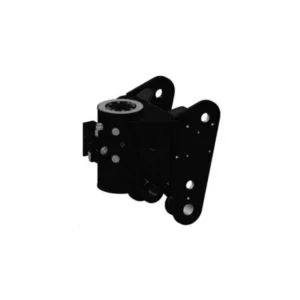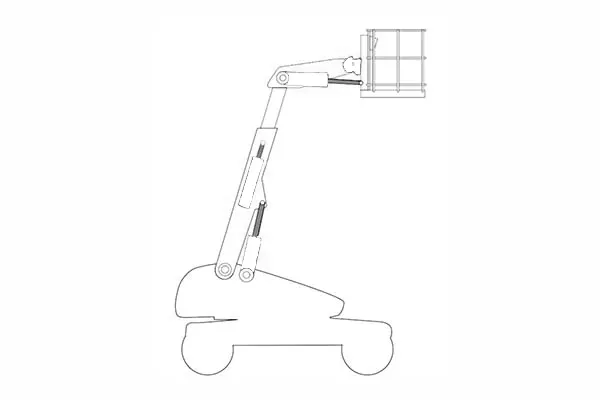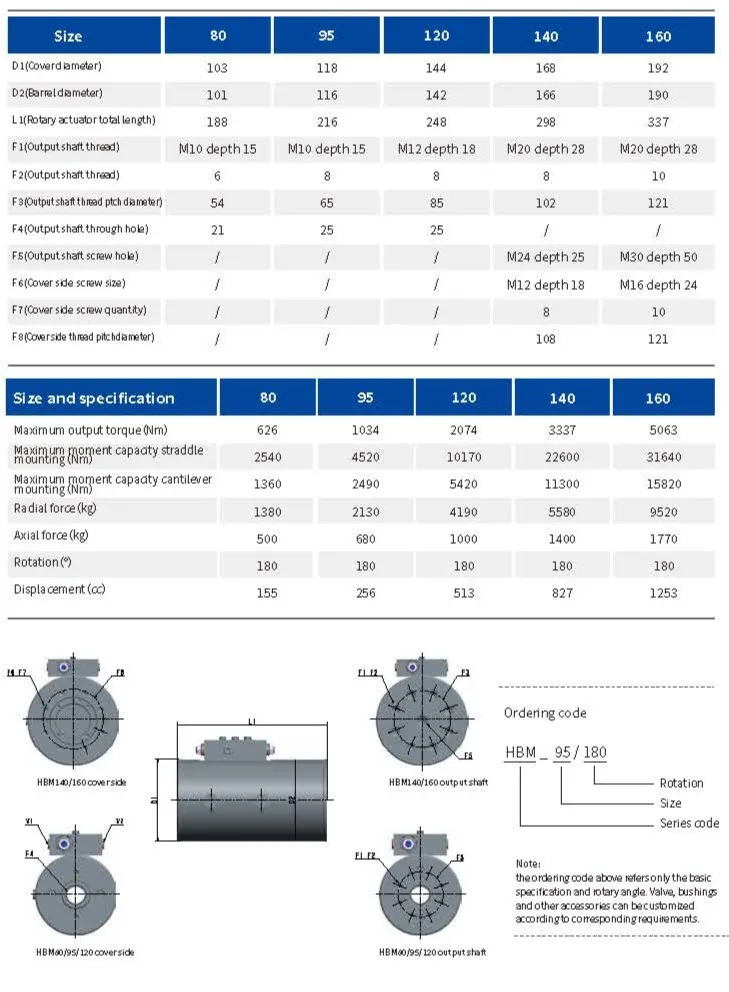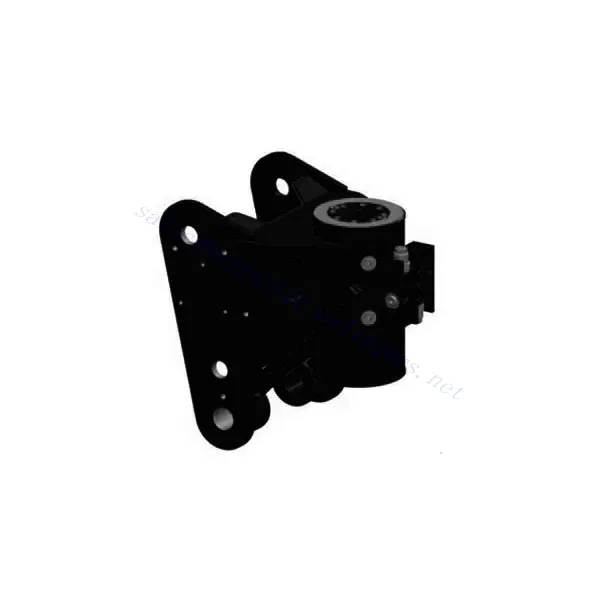Aerial Work Platform Rotary Actuator
Como um dos fabricantes, fornecedores e exportadores de produtos mecânicos de cilindros hidráulicos, oferecemos cilindros hidráulicos e muitos outros produtos.
Entre em contato conosco para obter detalhes.
Correio eletrônico:sales@hydraulic-cylinders.net
Fabricante, fornecedor e exportador de cilindros hidráulicos.
Aerial Work Platform Rotary Actuator

HBM series rotary actuator is a rotary actuator independently designed and developed for the arms control of articulated aerial work platforms. According to customer installation and performance requirements, the corresponding customized design can be realized to ensure the adaptability and flexibility of operation.
Based on the metric unit design, the unique seal and construction allow for a low coefficient of friction and high output torque. In addition, finite element analysis and durability testing contribute to the stability and reliability of the product. Compared with similar products on the market, the HBM series rotary actuator under the same product size, the output torque is increased by 10% ~ 20%, the cracking pressure is reduced by 50%, the operation is stable, the efficiency is higher, the cracking pressure is better, and finally ensure the safe, reliable and efficient work of the high-altitude working platform.
Aerial Work Platform Rotary Actuator Key Characteristics:
- Low Friction Coefficient:
- The critical component of the HBM series rotary actuator – the spiral spline for rotation and torque transmission,
features excellent precision, balanced stress distribution, and stable transmission. With the low-friction axial bearings and a unique sealing system design, the HBM series rotary actuator has a low friction coefficient during transmission.
- High Output Torque:
- Through continuous innovative research and validations, the HBM series rotary actuator is designed compactly to fully use the limited internal space and transmit high output torque via fluid pressure. Compared to similar products, the HBM series rotary actuator provides a 10% to 20% higher output torque under the same product size.
- Long Service Life:
- Comprehensive analysis and calculation on each size of the HBM rotary actuator are implemented with the assistance of FEA software during the design process. Besides, product optimization is continuously carried out to ensure that each product size can meet the long service life requirements.
- Except for regular factory tests, two dedicated rotary actuator endurance test benches are available for tests according to customer and application requirements, ensuring excellent durability and long service life.
Aerial Work Platform Rotary Actuator Parameter:
| Product Name | Aerial Work Platform Rotary Actuator |
| Features: | Realize platform and crank arm swing |
| Torque: | 500~5000N.m |
| Swing angle: | 0~360° |
| Pressure: | 21MPa(standard working pressure) |
| Rotary Actuator Applications: | Aerial Work Platform |
Aerial Work Platform Identification Diagram:

Aerial Work Platform Rotary Actuator Size And Specification:

Usage Method Of Aerial Work Platform Rotary Actuator:
- Actuator Installation:
- Follow the manufacturer’s instructions for proper installation of the aerial work platform rotary actuator.
- Ensure the actuator is securely mounted to the aerial work platform’s structure, providing a stable and reliable connection.
- Electrical and Hydraulic Connection:
- Connect the actuator to the electrical and hydraulic systems of the aerial work platform according to the provided guidelines.
- Ensure all connections are secure and properly sealed to prevent leaks or electrical malfunctions.
- Rotation Control:
- Utilize the control panel or interface provided to control the rotational movement of the aerial work platform.
- Follow the recommended operating procedures and safety guidelines for smooth and precise rotation.
- Safety Considerations:
- Before operating the aerial work platform, familiarize yourself with the safety features and emergency procedures.
- Ensure that all operators receive proper training on the safe operation of the platform and the aerial work platform rotary actuator.
How To Bleed Air From A Hydraulic System?
Bleeding air from a hydraulic system is a crucial maintenance procedure to ensure optimal performance and prevent spongy or inconsistent hydraulic operation. Here’s a step-by-step guide on how to bleed air from a hydraulic system:
- Identify Bleed Points:
- Locate the bleed points in the hydraulic system. These are typically found at high energies, such as on top of hydraulic cylinders, control valves, or pump reservoirs.
- Consult the hydraulic system’s manual or manufacturer’s guidelines to identify the specific bleed points for your system.
- Prepare the System:
- Turn off the power to the hydraulic system and relieve pressure by lowering or retracting hydraulic cylinders or releasing the pressure valve.
- Ensure you have the necessary tools and safety equipment to perform the bleeding process, including safety goggles and gloves.
- Position a Collection Container:
- Place a suitable container or drain pan beneath the bleed point to collect any hydraulic fluid that may be released during the bleeding process.
- This will help prevent spills and keep your work area clean.
- Open the Bleed Valve:
- Slowly and partially open the bleed valve at the designated bleed point using an appropriate wrench or tool.
- Be cautious not to fully remove the valve at this stage; instead, create a small opening to allow air and fluid to escape.
- Begin Bleeding:
- With the bleed valve partially open, activate the hydraulic system by turning it on or operating the relevant controls.
- Allow the hydraulic fluid to flow through the system, pushing out any trapped air bubbles. You will notice air and fluid escaping through the partially opened bleed valve.
- Monitor and Repeat:
- Monitor the fluid flow and observe any air bubbles escaping from the bleed valve.
- Once the fluid flow is consistent and free of air bubbles, close the bleed valve tightly to prevent any further air from entering the system.
- If air bubbles persist, repeat the bleeding process by partially opening the bleed valve again and allowing more fluid to flow through until the air is eliminated.
- Check Fluid Levels:
- After bleeding the air, check the hydraulic fluid level in the system’s reservoir or tank.
- Add additional fluid if necessary to maintain the recommended fluid level.
- Test and Verify:
- With the bleeding process completed and the hydraulic system reassembled, test the system’s operation to ensure smooth and consistent hydraulic performance.
- Verify that there are no unusual sounds or vibrations and that the system responds correctly to control inputs.
Aptidão e capacidade da fábrica:
(1) Montagem
Temos uma plataforma de montagem de pesquisa e desenvolvimento independente de primeira classe. A oficina de produção de cilindros hidráulicos tem quatro linhas de montagem semiautomáticas de cilindros de elevação e uma linha de montagem automática de cilindros de inclinação, com uma capacidade de produção anual projetada de 1 milhão de peças. A oficina de cilindros especiais é equipada com várias especificações de um sistema de montagem de limpeza semiautomática com uma capacidade de produção anual projetada de 200.000 peças e equipada com famosos equipamentos de usinagem CNC, um centro de usinagem, um equipamento especial de processamento de cilindros de alta precisão, uma máquina de solda robotizada, uma máquina de limpeza automática, uma máquina de montagem automática de cilindros e uma linha de produção de pintura automática. O equipamento crítico existente é de mais de 300 conjuntos (conjuntos). A alocação ideal e o uso eficiente dos recursos do equipamento garantem os requisitos de precisão dos produtos e atendem às necessidades de alta qualidade dos produtos.


(2) Usinagem
A oficina de usinagem é equipada com um centro de torneamento de trilho inclinado personalizado, um centro de usinagem, uma máquina de brunimento de alta velocidade, um robô de soldagem e outros equipamentos relacionados, que podem lidar com o processamento de tubos de cilindros com diâmetro interno máximo de 400 mm e comprimento máximo de 6 metros.

(3) Soldagem

(4) Pintura e revestimento
Com linhas de revestimento de tinta à base de água automáticas de cilindros de pequeno e médio porte, para obter carregamento e descarregamento automáticos de robôs e pulverização automática, a capacidade projetada é de 4.000 peças por turno;
Também temos uma linha de produção de tinta semiautomática para cilindros grandes, acionada por uma corrente elétrica, com capacidade de projeto de 60 caixas por turno.


(5) Testes
Temos instalações de inspeção e bancos de teste de primeira classe para garantir que o desempenho do cilindro atenda aos requisitos.

We are one of the best hydraulic cylinder manufacturers. We can offer comprehensive hydraulic cylinders. We also provide corresponding caixas de câmbio agrícolas. Exportamos nossos produtos para clientes em todo o mundo e conquistamos uma boa reputação devido à qualidade superior de nossos produtos e ao serviço pós-venda. Convidamos clientes nacionais e estrangeiros a entrar em contato conosco para negociar negócios, trocar informações e cooperar conosco!
Faça um tour pela nossa fábrica de RV:
Faça um tour pela nossa fábrica de RV com o seguinte
Como funciona o cilindro hidráulico da empilhadeira?
Cilindro hidráulico Aplicação:


